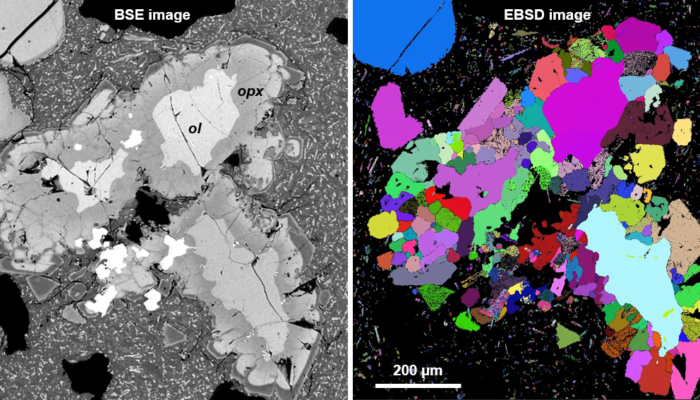
In this interview, I talk with Chris Conway about his experience as a volcanologist in Japan, which is one of the countries with the highest volcanic threat in the world. You will read how studying crystals found within erupted lava flows can help hazard mitigation at active volcanoes and how volcanic hazard is managed in Japan.
Hi Chris!! Thank you for accepting this interview, first and foremost, please tell us about yourself and what brought you to Japan
I am a Researcher in volcanology at the Geological Survey of Japan (GSJ). I grew up in New Zealand and received my PhD from Victoria University of Wellington in 2016. During my PhD studies, I attended the 2013 Scientific Assembly of the International Association of Volcanology and Chemistry of the Earth’s Interior (IAVCEI) in Kagoshima, Japan. As well as enjoying the academic aspects of my first international conference, I realized that Japan would be a great place to work and live. I got my chance to do that in 2016 when I moved here after receiving a post-doctoral research fellowship from the Japan Society for the Promotion of Science (JSPS) and the Royal Society of New Zealand (RSNZ). I was hosted at the National Museum of Nature and Science by Dr Ken Tani, whom I had met in 2015 during a survey of a submarine volcano north of New Zealand. After my two-year postdoc, I began my current position in the Volcanic Activity Research Group at GSJ, where I use petrology, geochemistry, and geochronology to investigate the processes and timescales of magma formation and eruption at active volcanoes in Japan and around the world.
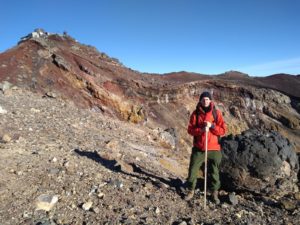
Chris Conway at the summit of Japan’s tallest volcano, Mount Fuji (3,776 m). Photo Credits: Chris Conway.
Your recent work on Ruapehu volcano looks very promising. Could you please elaborate on the work you carried out and some of your results?
My colleagues and I recently had a paper published in Geology that provides new constraints for the timing of magmatic processes that precede lava flow eruptions at Ruapehu volcano, which is an active stratovolcano in New Zealand [1]. Due to their relatively high abundances of olivine, the lava flows that we studied have higher magnesium content when compared with other lavas at Ruapehu. We found that these olivine crystals were carried up by magma from the mantle beneath Ruapehu (more than 25 km deep) into the mid-crustal storage region (10–15 km deep) of a more crystal-rich magma type. Mixing between the two magma types caused high-Mg (magnesium) rim zones to grow around the relatively high-Fe (iron) core zones of pyroxene crystals from the mid-crustal magma. Due to the process of Fe-Mg interdiffusion in these crystals (Figure 2), which means that there is an exchange of atoms from zones of high to low concentration, the boundaries between crystal cores and rims changed from sharp, during magma mixing to smoothed at the eruption.
We used the known rate of diffusion to calculate how long it took for this process to occur in the crystals from our samples, and discovered that the time lag between magma mixing in the crust and eruption at the surface was less than 10 days for most lava flows. Considering the scenario of a future eruption at Ruapehu volcano, if magma mixing in the crust produces signs at the surface that can be detected by geophysical monitoring equipment (for example ground deformation, earthquakes, gas emission), there may be a similarly short time period between the recognition of precursory unrest and the onset of an eruption. To ensure that pre-eruption processes can be accurately identified to assist hazard mitigation in the future, volcanologists are retroactively comparing the time series of magmatic phenomena recorded by monitoring and petrology for recent eruptions at volcanoes around the world, such as at La Réunion [2] and Iceland [3]. This continues to be one of the most exciting research fields in volcanology, as new experimental and analytical techniques open up the possibility of utilizing a wider range of minerals and elements in volcanic rocks to determine precise and accurate eruption time scales.
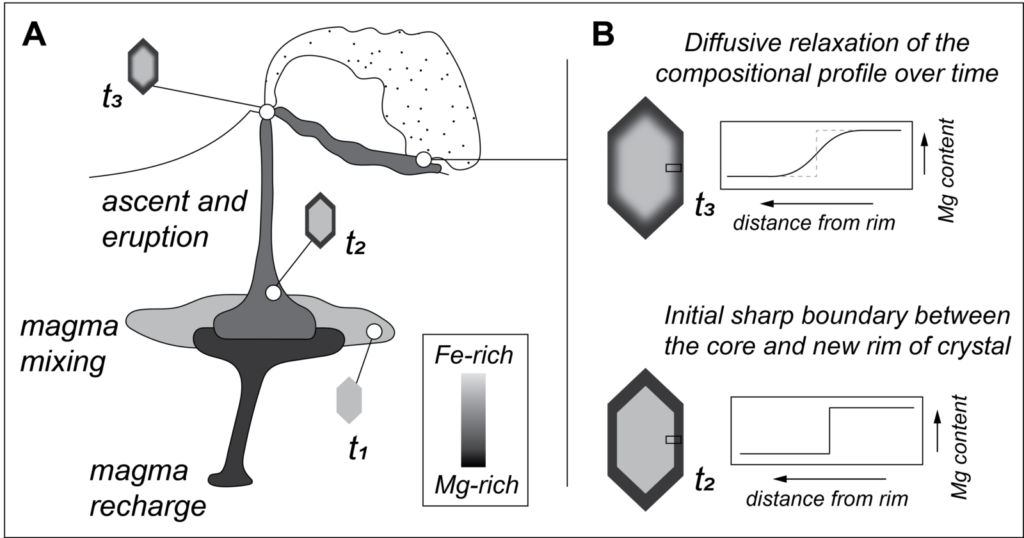
Figure 2. This summary cartoon shows the changes to chemical zoning inside a crystal during magma mixing and eruption. Diffusion chronometry is a key tool for understanding the time scales of processes that occur prior to eruptions. Image modified from [4].
There has been increasing demand by the society/government to carry out geological hazard assessment especially after the nuclear meltdown during the 2011 Tohoku earthquake (Mw 9.1-9.3), and the growing population around the active volcanoes, so what is the status of volcanic hazard assessment and outreach programs in Japan?
Japan has 111 active volcanoes, which are classified as having erupted within the last 10,000 years (Figure 3). Some of these have frequently been active over the last 500 years and have the potential to cause significant damage and disruption throughout the country. As such, volcano monitoring is a critical endeavour in Japan.
The Japan Meteorological Agency (JMA) is responsible for coordinating volcano monitoring activities with several other institutes and universities, and for issuing volcanic eruption alerts and warnings. JMA operates Volcanic Observation and Information Centers in Tokyo, Fukuoka, Sendai, and Sapporo, where they oversee the 24-hour operation of monitoring instruments (including seismographs and cameras) at 50 volcanoes. GSJ researchers produce geological maps and eruption histories that provide the necessary framework for forecasting the types and timescales of eruptive behaviour at active volcanoes and conduct rapid response surveys to collect and analyze volcanic ash during eruptions. For research purposes, other institutes and universities in Japan also collect geophysical and gas data for recently active volcanoes, while distant islands and submarine volcanoes are monitored by the Japan Coast Guard. The Japanese Coordinating Committee for the Prediction of Volcanic Eruptions, which is commissioned by JMA, then uses the data and expertise from the various sources. During periods of heightened unrest, they evaluate and forecast volcanic activity, and issue volcanic warnings to the public through the local governments. Through the Tokyo Volcanic Ash Advisory Center (VAAC), JMA also provides information for the distribution of atmospheric ash clouds from volcanoes in the Philippines, Japan, and Russia to avoid aviation disasters.
Among the different types of volcanic activity in the country, phreatic eruptions, which are steam-driven explosions from the hydrothermal systems at volcanoes, pose a major challenge because they can occur with very little warning and are therefore extremely difficult to forecast. Recently, efforts have been made to improve the understanding of precursory signals for phreatic eruptions so that volcanic risk can be minimized in popular tourist destinations around volcanic hot springs [5].
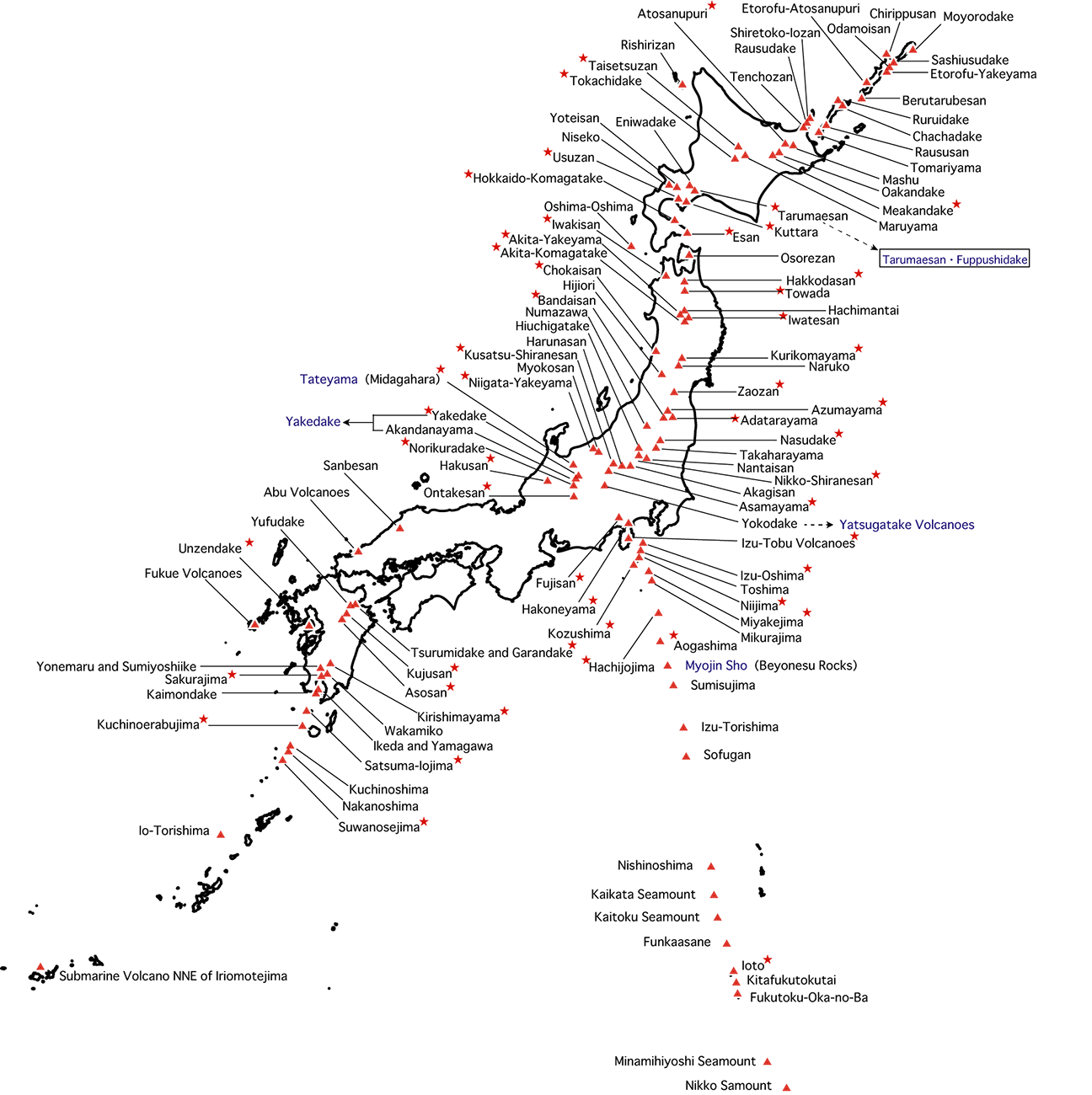
Figure 3. Map of active volcanoes in Japan. Red stars are shown next to the names of volcanoes that are continuously monitored by JMA. Image credit: GSJ.
It seems you are enjoying being a volcanologist, that leads to my next and final question: how has been your experience so far!!
I have been really fortunate to experience a wide range of opportunities throughout my research. My job involves collecting volcanic rock samples in the field and taking them back to the laboratories at GSJ to measure their physical and chemical properties. To collect samples from submarine volcanoes (Figure 4), I have been able to go on research cruises in the oceans around New Zealand and Japan. Spending three weeks on a ship is challenging but very rewarding because we get to explore regions of the seafloor for the first time. On land, exploring remote parts of active volcanoes and observing volcanic eruptions from a safe distance is also fun (Figure 5). Lab work involves preparing samples by cutting, crushing and polishing pieces of volcanic rock, and using micro-analytical instruments that can reveal their physical and chemical features on sub-mm scales. Discovering tiny details in the crystals and rocks that make up Earth’s crust is really cool. GSJ has the only museum in Japan that is dedicated solely to geology, so it is great to be able to share these discoveries with the public.
I recently became the vice-Chair for the IAVCEI Commission on Volcano-Ice Interactions, and am enjoying the challenge of bringing together researchers from around the world who work on the ~250 volcanoes that currently host glacial ice. Ice-covered volcanoes will pose significant hazards in the future as glaciers respond to climate change, but they also provide valuable archives of past climate in their stratigraphic records, so this is a fascinating field of research right now.
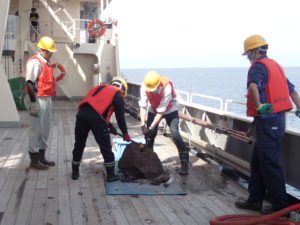
Figure 4. Researchers attempt to break up a large block of lava, recovered by seafloor dredge sampling near Hokkaido, Japan, on the Hakuho Maru research vessel. Photo credit: Chris Conway.
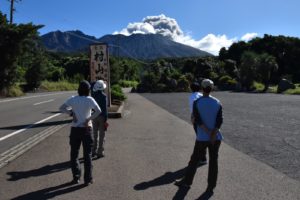
Figure 5. Researchers observe a minor ash eruption at Sakurajima volcano, Japan, from a safe distance in November 2019. Photo credit: Chris Conway.
References
[1] Conway, E. C., Chamberlain, J.K., Harigane, Y., Morgan, D.J., Colin, J.N.W., (2020) Rapid assembly of high-Mg andesites and dacites by magma mixing at a continental arc stratovolcano. Geology (2020) 48 (10): 1033–1037. https://doi.org/10.1130/G47614.1
[2] Albert, H., Costa, F., Di Muro, A., Herrin, J., Métrich, N., Deloule, E. (2019). Magma interactions, crystal mush formation, timescales, and unrest during caldera collapse and lateral eruption at ocean island basaltic volcanoes (Piton de la Fournaise, La Réunion), Earth and Planetary Science Letters, Volume 515,2019, Pages 187-199. https://doi.org/10.1016/j.epsl.2019.02.035
[3] Pankhurst, J. M., Morgan D.J., Thordarson, T., Loughlin, S.C. (2018). Magmatic crystal records in time, space, and process, causatively linked with volcanic unrest. Earth and Planetary Science Letters, Volume 493, 2018, Pages 231-241 https://doi.org/10.1016/j.epsl.2018.04.025
[4] Costa, F., Shea, T. & Ubide, T. (2020). Diffusion chronometry and the timescales of magmatic processes. Nat Rev Earth Environ 1, 201–214 (2020). https://doi.org/10.1038/s43017-020-0038-x
[5] Mannen, K., Roman, D., Leonard, G. et al. Special issue “Towards forecasting phreatic eruptions: examples from Hakone volcano and some global equivalents”. Earth Planets Space 71, 91 (2019). https://doi.org/10.1186/s40623-019-1068-9
Post edited by Valeria Cigala, Asimina Voskaki.
